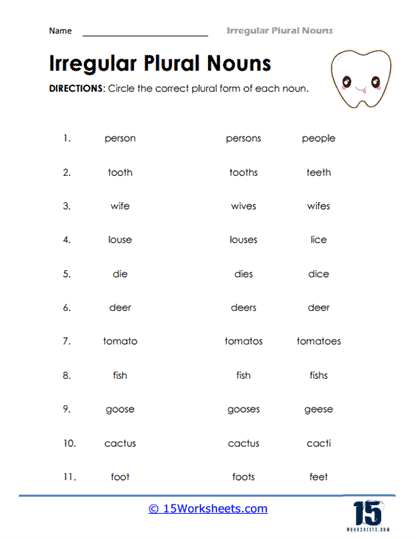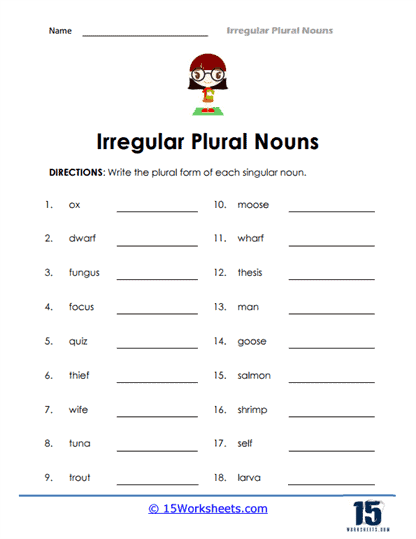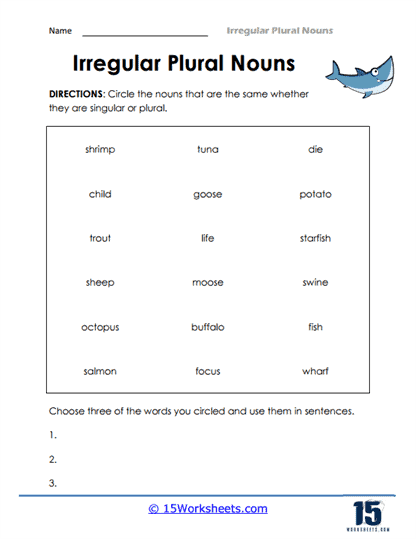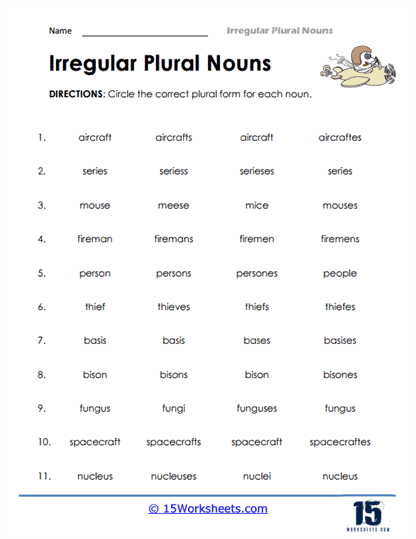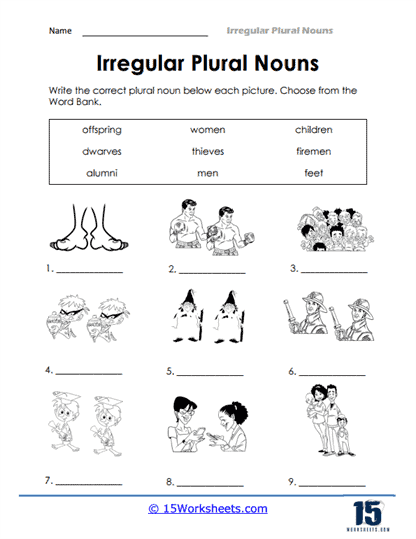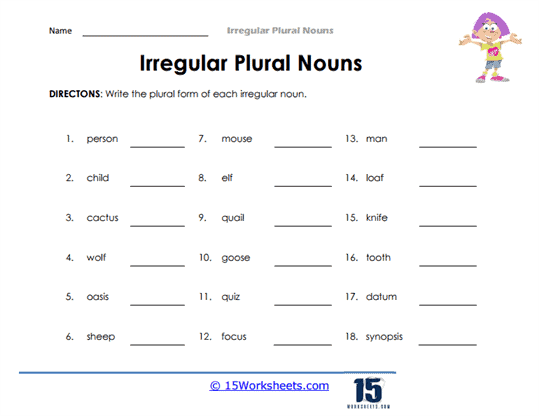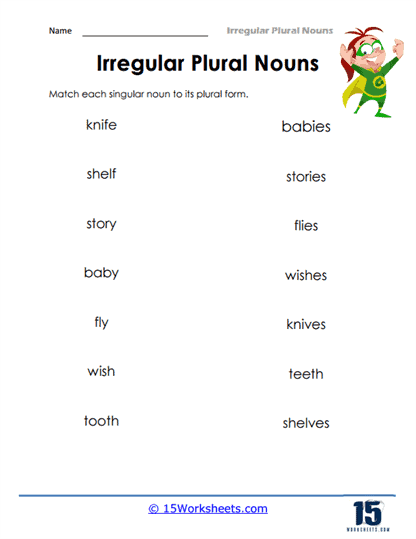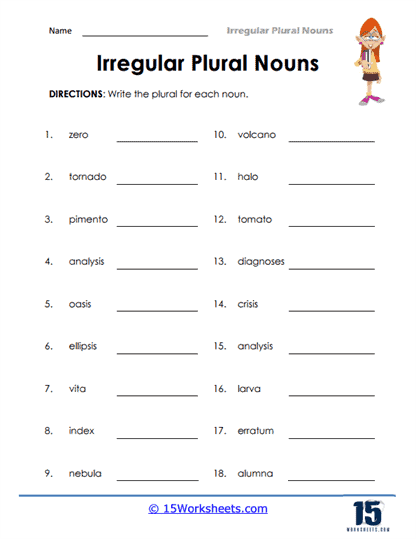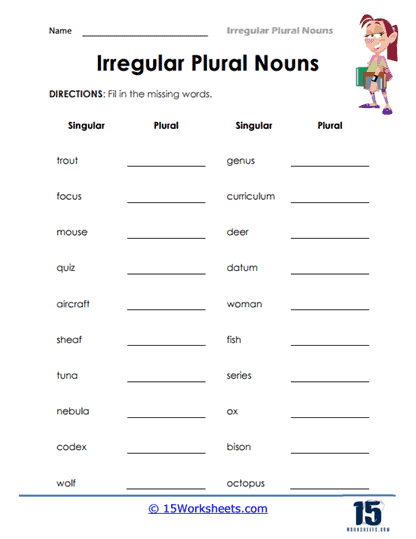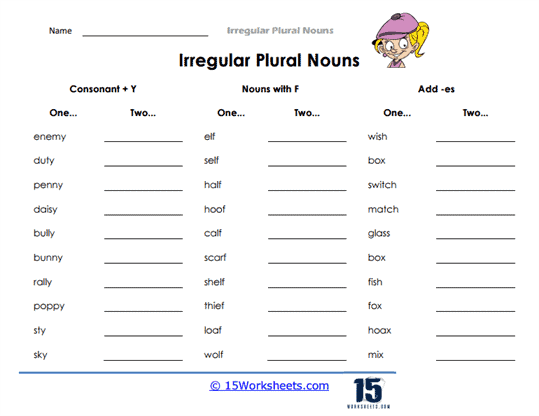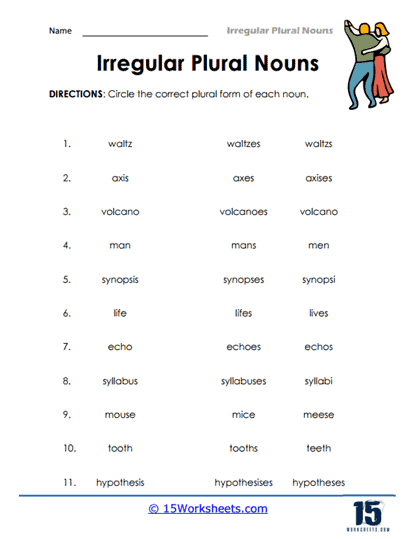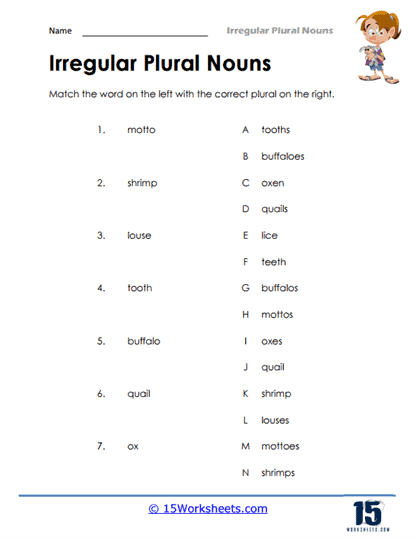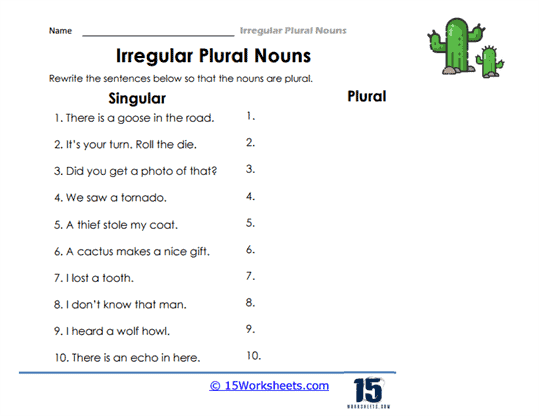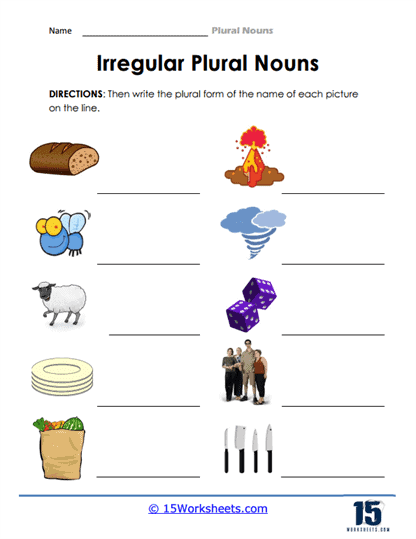Irregular Plural Nouns Worksheets
All About These 15 Worksheets
These irregular plural nouns worksheets are designed to help students practice and master the unique forms of plural nouns in the English language that do not follow the regular rules of adding -s or -es to the singular form. These worksheets include activities that require students to identify, form, and use irregular plural nouns correctly in sentences.
The worksheets provide learners with lists of common irregular plural nouns or their singular forms to help them memorize and internalize the irregular noun forms. Activities on these worksheets may include matching singular nouns and their corresponding irregular plural nouns, filling in the blank with the correct form of the irregular plural noun, and rewriting sentences using irregular plural nouns.
Some worksheets in the collection also include pictures to help students better identify and understand the irregular plural noun forms. Using these worksheets on irregular plural nouns, teachers can help their students improve their knowledge and understanding of the English language’s complex plural noun system. Through these worksheets, students will:
- Be familiar with the commonly used irregular plural nouns;
- Learn the correct form of irregular plural nouns;
- Write their own sentences using irregular plural nouns;
- And master certain rules in changing singular nouns to its correct irregular plural form.
Overall, consistent practice with irregular plural nouns can help the students build their vocabulary, increase their writing and speaking skills, and ultimately become more effective communicators in the English language.
What Are Irregular Plural Nouns?
Irregular plural nouns are words that do not follow the rules of regular plural nouns. Regular plural nouns add -s, -es, or -ies to the end of nouns to indicate there is more than one. Any noun that does not change its spelling in such a way is classified as an irregular plural noun.
One of the reasons for these irregular plural nouns is that many of these words originate from other languages such as Old English, French, Latin, Greek, and Arabic. Therefore they follow the pluralization rules of those languages.
This characteristic of irregular plural nouns makes them challenging to teach and learn. As no strict rules explain how these words are pluralized, memorization is the only way to know them.
Specific nouns can be grouped under generalized rules, but there are exceptions for each one. These broad categories are explained below.
Nouns That End With -f or -fe
For nouns that end in -f, the f is converted to a v, and -es is added to the end. Examples are given in the table below.
| Singular | Plural |
| calf | calves |
| leaf | leaves |
| shelf | shelves |
| loaf | loaves |
If the noun ends in -fe, the f is converted to a v, and -s is added to the end. Examples are given in the table below.
| Singular | Plural |
| knife | knives |
| life | lives |
| wife | wives |
Examples of exceptions: roof (plural: roofs) and proof (plural: proofs).
Nouns That End With -o
Words that end in -o are usually pluralized by adding -es. Examples are given in the table below.
| Singular | Plural |
| tomato | tomatoes |
| potato | potatoes |
| hero | heroes |
| veto | vetoes |
Exceptions to this are words that are taken from other languages, such as piano (plural: piano), photo (plural: photos), and cello (plural: cellos).
Nouns that End With -is
English words that end with is are made plural by changing the -is to -es. Examples are given in the table below.
| Singular | Plural |
| diagnosis | diagnoses |
| analysis | analyses |
| thesis | theses |
| antithesis | antitheses |
| basis | bases |
Nouns That End With -us
In such words, the -us at the end is changed to an -i. Examples are given in the table below.
| Singular | Plural |
| cactus | cacti |
| nucleus | nuclei |
| octopus | octopi |
| focus | foci |
| fungus | fungi |
Nouns That End With -os
In nouns that end in -os, these letters are replaced with -a. Examples are given in the table below.
| Singular | Plural |
| criterion | criteria |
| phenomenon | phenomena |
Nouns That End With -um
Words that end in -um are pluralized by replacing these two letters with -a. Examples are given in the table below.
| Singular | Plural |
| bacterium | bacteria |
| datum | data |
| memorandum | memoranda |
| stratum | strata |
| curriculum | curricula |
| medium | media |
| ovum | ova |
Nouns That End With -ix
There are two ways to pluralize nouns that end in -ix. Either -es is added to the end, or the x is replaced by a c changing the ending to -ices. Some words have accepted versions of both spellings, while others only have one accepted version.
| Singular | Plural |
| appendix | appendixes or appendices |
| vortex | vortexes or vortices |
| index | indexes or indices |
| codex | codices |
| axis | axes |
| matrix | matrices |
Nouns Where Vowels Change
Several nouns change vowels when pluralized. For example, oo becomes ee, or an becomes en.
| Singular | Plural |
| tooth | teeth |
| goose | geese |
| man | men |
| woman | women |
Some Change Completely
Certain irregular nouns change their spelling completely when made plural.
| Singular | Plural |
| mouse | mice |
| louse | lice |
| die | dice |
| ox | oxen |
| person | people |
| child | children |
| opus | opera |
They That Do Not Change
There are specific nouns that do not change their spelling at all when pluralized. Examples are given in the table below:
| Singular | Plural |
| moose | moose |
| fish | fish |
| sheep | sheep |
| shrimp | shrimp |
| aircraft | aircraft |
| deer | deer |


